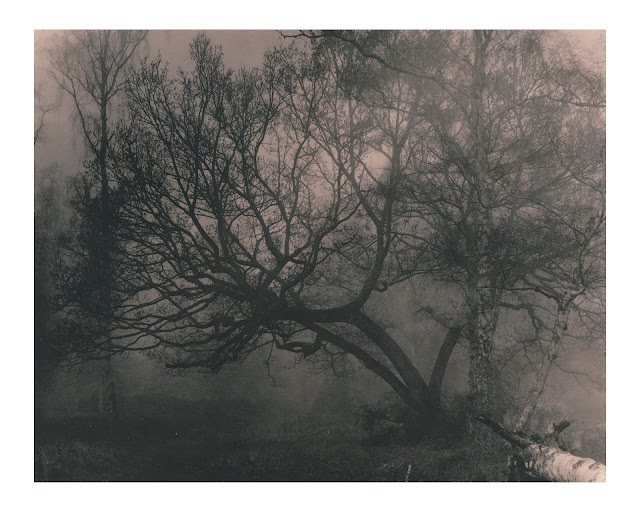Lith Printing Foggy Oak: Day Two
So I followed up this morning on my successful run yesterday. I started out with Fotospeed lith paper and exposed 2 sheets at f8 for 64 seconds dodging the dark portion as yesterday for 32 seconds. My previous notes indicate Fotospeed likes more light so I opened the aperture 2 stops.
The first image caught infectious develop on the edges of the tree and many of the highlights did not catch up. Not great and a testimony to the instability of the process. I think perhaps less exposure is in order.
 |
| Fotospeed Paper (f8 64 seconds, dodge tree/lower right corner 32 seconds) |
The next print came out much better despite being almost identical. Again fairly dark so less exposure by a stop if I decide to try this again. The lovely warm salmon tones are present that makes the paper so wonderful to lith (I am now down to 4x 8x10 sheets!) I like this one.
 |
| Fotospeed Paper (f8 64 seconds, dodge tree/lower right corner 32 seconds) |
For the next set I made two identical exposures on Oriental Seagull #2 paper again. This time a refreshed the developer after the Fotospeed paper and added 300ml of concentrated salt solution. I Mixed 100g of sea salt in 400ml of cold tap water and stirred and let stand. There was still undissolved salt in the bottom of the jar. I added 300ml of this to the refreshed developer (16 Part A + 18g Part B + 15g 10% Sodium Sulfite).
I am trying the sea salt addition based on some work done by Grainy Vision who intrepidly makes developers from scratch. She suggest adding chloride in the form of kosher (non-iodized) salt. She says...
The actual effects on tonality with chloride are fairly minor, tending to produce more golden and yellow tones rather than peach and making the famously neutral tone Foma emulsions pick up a hint of warmth in the highlights.
I used the same f16 64 seconds exposure and dodge of the darker tree portion for 32 seconds as yesterday. Both prints tended to catch first on the edge of the tree as did the Fotospeed above. The race was on and there was some tension to see if the rest of the shadows tones would catch up before the highlights closed in.
 |
| First Seagull with Chloride (64 seconds, dodge tree/lower right corner 32 seconds) |
 |
| Seconds (and best!) Seagull with Chloride (64 seconds, dodge tree/lower right corner 32 seconds) |
Guessing the snatch point was difficult as the process is irreversible and I really wanted to have balanced shadow tones throughout the tree branches and trunk. I got there in the end but the highlights got fairly dark. What I did achieve was a nice patch of light in the center as if the sun is lighting the fog from behind. (It is not and is actually to my left and above; this is the random wonder of lith printing.)
As for the salt/chloride addition it did not extend development much if at all. (Fotospeed paper is almost twice as fast developing in lith as the Seagull is.) As for change of tone it became more neutral compared to yesterday's plain lith development session. In reflected daylight in my office and in direct sunlight I see a definite move from a warm pinkish tint on the original prints to a more neutral tone but definitely not cold or pure black. There may be traces of green but not distressingly so.
 |
| Seagull Comparison (left with sea salt/chloride, right normal development) |
My initial thoughts on the chloride on Seagull (oddly appropriate sounding) is that it could be a tool in the arsenal if I want to represent a print closer to conventionally developed prints.
Comments